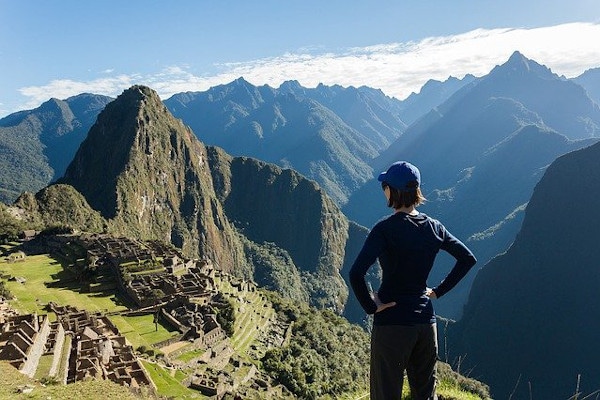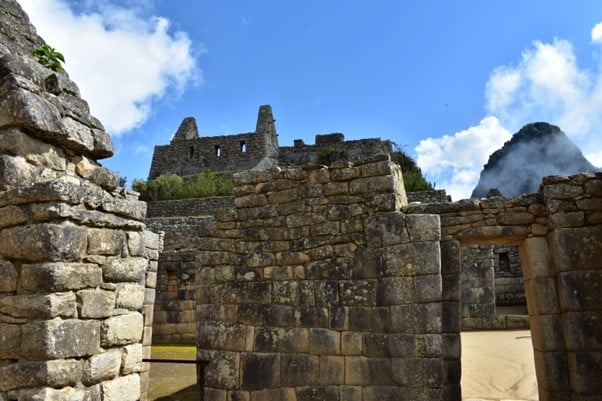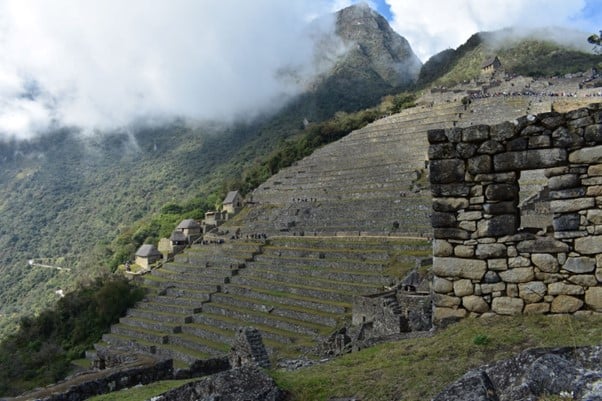The Inca Trail is about re-tracing the pilgrimage of an ancient civilization. Inca Trail ruins are scattered along the route. They provide a fascinating insight into the past. These archeological marvels are appetizers for the most famous Incan ruins of all - Machu Picchu.
Maybe you have already signed up for the Inca trail hike and are impatient to know more about the ruins.
In this article, I will outline some of the most interesting structures you can look forward to exploring on the Inca Trail.

Get a Machu Picchu trek quote
Start planning your Machu Picchu hiking holiday.
Inca Trail Ruins: 8 Remarkable Archeological Sites
The Inca Trail Ruins and What to Expect
Some people say that the Inca Trail ruins along the famous hiking route are actually more rewarding than visiting Machu Picchu itself.
This may be an overstatement (Machu Picchu is mind-blowing!); however, the lesser-known ruins do have many plus points.
Firstly, only hikers on the classic Inca Trail have access to these ruin sites. Seeing these ruins is a privilege and reward for undertaking this particular trail.
Secondly, when seeing the ruins on the Inca trail, you will almost have the place to yourself. Your views and pictures will not be interrupted by the 2,000 odd tourists a day admitted to Machu Picchu.

8 Amazing Ruins on the Inca Trail
1. Llactapata/Patallacta
After only 6km (3.8 mi) of hiking, you will reach the first set of Inca Trail ruins.
Llactapata (sometimes called Patallacta) means ‘high city’ in Quechua. It consists of a ceremonial center, huge agricultural terraces, an urban center, and a cemetery.
These 16th-century structures are 2,840m (9,318ft) high on the Cusicancha river’s left bank. This site was once a stop-over for people traveling between Cusco and Machu Picchu.
Hiram Bingham, famous for discovering Machu Picchu, was the first westerner to note this site in 1912. It was only investigated thoroughly in 2003 on an expedition led by Thompson and Ziegler.
You will see this site from a viewpoint along the trail. If your group is making good time during your hike, you may get the opportunity to go down and do some exploring.
2. Runku Rukay
On day 2, you will get to see the Runku Rukay (or Runkurukay) ruins. These are halfway up the second high pass of the trail of the same name. ‘Runku’ is a type of log, perhaps a reference to the general shape of the site.
You can’t miss the simple but dramatic structure with high stone walls in a half-circle shape. This is an unusual design for Incan architecture, yet fascinating to tourists from all over the world.
It is thought that this site was an administrative station and rest stop for messengers on the trail. These runners relayed messages up and down the trail. They were the only form of communication between trail campsites and traveling parties.
Fast Fact: Specialized trail messengers are known as Chasqui. Messages were encoded as knots on different colored threads. Only certain people understood the knot system. This prevented information from falling into the wrong hands.
3. Sayacmarca

As you descend the pass on your third day, you will see the Sayacmarca archeological site. Sayacmarca roughly translates as ‘Town you cannot enter’. This site is high on a cliff with steep drops on 3 of 4 sides.
The hike to reach Sayacmarca is up 98 stone stairs carved into the side of the mountain to get there. From Sayacmarca, there are panoramic views of the Alabama Valley.
The site is separated into the sun temple and the residential area with narrow corridors. The Colla civilization originally built this structure. During the time of the Incan civilisation, builders added water canals to the temple and houses.
Based on the site's position, it may have been a strategic defense or look-out point as well as a rest station. There is no way to know for certain.
4. Phuyupatamarca
This ‘cloud town’ is about a 2 hour walk from Sayacmarca. There is often mist covering part of the site. This gives the impression that the ruins are floating in clouds. It is perched on the slope of a forested valley, making it particularly photographic for tourists in the area.
This is one of the best-preserved sites for Inca Trail ruins. You will notice the large flat platforms and buildings positioned for astronomy. Above the terraces, there are remains of the irrigation system, bridge as well as a fountain. Baths are an interesting feature here. These were probably used for ritual cleansings.
On a clear day, you can see all the way northwards across the valley to Intipata.
Where to stay? Here are 5 of my favourite accommodation options in Cusco:
- Sonesta Hotel (great 4 star hotel)
- Antigua Casona San Blas
- El Mariscal Cusco (very good value)
- Hotel Paradis (good 3 star hotel)
- Quechua Hostal Recoleta (cheap and cheerful)
See more Cusco accommodation options.
5. Winay Wayna
On day 4 of the Inca Trail, you will reach the Winay Wayna ruins. In Quechua, it is spelled ‘Huinay Huayna’, which means ‘forever young’. Winay Wayna’s main feature is a set of extensive terraces overlooking the Urubamba river.
Higher and lower sections of housing are linked by fountains and canals. It is not known exactly what the site was for. Most historians suggest that Winay Wayna was an agricultural center and food warehouse. It was likely also an administrative and spiritual center.
This is arguably the most impressive site of the Inca Ruins on the route to Machu Picchu. The structures are in great condition which is amazing after 500 years of natural elements. These ruins hold their own against the world-famous citadel which is only 3 miles (5km) away.
6. Intipata Ruins
Intipata (Sun Terrace) is located at 2840m (9318 ft) above sea level. It is one of the steepest and most impressive sets of terraces along the Inca trail. Crops like potatoes, corn, oca, quinoa, and coca leaves were grown here.
The site was one of many checkpoints along the trail. Its location provided a good surveillance point to observe travelers on their way to Machu Picchu.
Hikers get to see this site after a long downhill hike at the end of day 3 on the Inca Trail. Because the slope is so steep, few people actually get to hike onto the site. If you are feeling up to it and running ahead of time, you may be able to convince your guide to take a closer look.
7. The Sun Gate (Inti Punku)
On your final day, you will reach the Sun Gate of Machu Picchu. This famous arch is considered the finish line of the Inca Trail hike. For the Incan people, Inti was the Sun God, one of the most important deities in their belief system.
This structure was explicitly placed on a ridge on Machu Picchu’s eastern slope. During the Summer solstice, the sun passes directly through the arch. Regardless of your spirituality, witnessing this is a mesmerizing experience.
Looking for a day tour? Here are my 5 favourite day tours around Cusco:
- Rainbow Mountain day trip (with meals)
- Moray and Salt Mines Quad Bike Tour
- Sacred Valley day tour
- Humantay Lake day tour
- Machu Picchu and Huayna Picchu entrance tickets
See more Cusco day trips.
8. Machu Picchu
The biggest and arguably best Inca Trail ruins wait for you at the end of the hiking route. Machu Picchu is the prize for completing 4 days of hiking. These ruins are not only famous but have been added to the list of the new 7 wonders of the world.
Fast Fact: Incans built the great Citadel in 1450 as a residence for rulers. Here, you will see temples, farming terraces, and canals channeling mountain water. Machu Picchu was completely self-sufficient. In its glory days, there may have been as many as 1000 people living here!
The Citadel was abandoned in 1530 after the Spanish arrived in Peru. Fortunately, the European conquerors did not discover and destroy the intricate stonework. Many of Machu Picchu's structures remain intact for us to marvel at today.

Get a Machu Picchu trek quote
Start planning your Machu Picchu hiking holiday.
Do you want to know more about sites of these famous Inca Train Ruins? We have another whole article on Interesting Machu Picchu facts and Lake Titicaca ruins.
